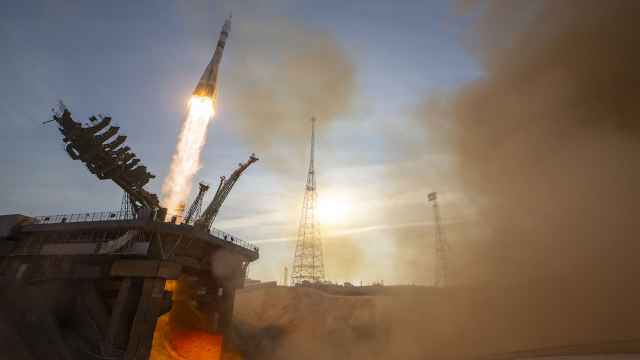SOCHI — In April, at the end of another seemingly endless winter, most Russians are eager to get rid of the piles of snow that have clogged their cities and streets and yards for months.
Yet down south in the Black Sea resort of Sochi, fleets of heavy machinery and a corps of laborers are hard at work trying to store acres of the freezing white stuff for the 2014 Winter Olympics.
Two test events for the Sochi games — snowboarding parallel slalom and slope-style skiing — had to be canceled in February because of lack of snow or rainy weather in the region set along Russia's southern border. That raised alarms for Russian organizers, who shuddered to think of the blowback if the same problem turned up when the world is watching the Sochi Olympics, which run from Feb. 7 to 23 next year.
So organizers are gathering up 450,000 cubic meters of snow and trying to keep it from melting away this summer. That's roughly the same volume as the Cologne Cathedral or about how much water flows over Niagara Falls in four minutes — by any measure, a big amount.
"This is kind of a safeguard for the future," said Sergei Bachin, general director of the Roza Khutor resort, which will host Sochi's Alpine skiing and snowboarding events.
In another layer of protection for the games, Roza Khutor also boasts of what it claims to be Europe's biggest snow-making system.
"We can make such an amount of snow over several nights that we could host the games even if there was not a single snowfall," Bachin said in an interview.
Sochi, a city of 343,000 people, sprawls over extremely varied terrain, from the palm trees lining its Black Sea coast to the soaring mountains 40 kilometers inland. The region has received billions in development funds over the last few years — at an estimated cost of about $50 billion, the Sochi games are on track to be the world's most expensive Olympics — but it's still an area where the weather can change markedly and forecasters have trouble predicting what's next.
Roman Vilfand, chief of the Russian Meteorological Office, told reporters that his agency was struggling to accurately predict how much snowfall Sochi's mountain area will get in February because of a shortage of regional data. There's a weather station in the Krasnaya Polyana settlement in the mountains, but it's 500 meters below the competition slopes and has been operating only for 10 years.
According to that data, 1 degree Celsius is the average daytime temperature in February for Krasnaya Polyana. But temperatures are generally lower at higher altitudes above the station.
The uncertainties have prompted a massive Russian response.
Slurping up icy-cold water from two artificial lakes, some 200 snow-blowing machines at Roza Khutor have been making tons of artificial snow throughout the 2012-13 winter season.
This month, dozens of snowcats on caterpillar treads are roaming the slopes, pushing snow into eight enormous piles that are dozens of meters high and close to key Olympic courses.
Workers in the operation wear safety equipment similar to that of rock climbers. Before blanketing a snow pile with insulated material, they drill meter-deep holes in it to secure wooden anchors, attached by a rope to a wooden plank that runs along the pile.
The pile is then covered with hundreds of 22-millimeter-thick insulated blankets with reflective surfaces. Those are linked with hook-and-loop tapes and then with adhesive tape, and more wooden planks are piled on top.
Russian organizers are determined to avoid a repetition of the 2010 Winter Olympics in Vancouver, where unusually warm weather produced the nickname of the "Brown Games" and left those in charge frantically looking for a way to bring more snow to the venues.
The month of January 2010 turned out to be the warmest on record there. Daytime temperatures of 11 degrees Celsius prevented Vancouver organizers from using snow-blowing machines already on some trails at the Whistler Blackcomb resort where the Alpine events were being held.
Instead, organizers had to fly in snow by helicopter from mountains 800 kilometers further north. Tons of snow was also shipped by giant trucks from three hours away and the Olympic mountain slopes were studded with tubes of dry ice to keep the snow from melting.
In Sochi, the organizers are confident that their snow piles will see them through. In a test overseen by leading experts in snow storing, workers at Roza Khutor last winter built a snow pile of 10,000 cubic meters that lasted through October of last year.
"We're not afraid that we'll be short of snow. This is our backup option," said Mikhail Tigushkin, the sport events manager at Roza Khutor, speaking on top of a 70,000 cubic-meter snow pile in early April.
Tigushkin said half of last year's snow heap had melted over summer but he insisted that the larger piles now being built would be able to preserve a far higher percentage of the snow.
Snow from those open-air storages can be shoved down the mountains by snowcats or transported elsewhere during the games no matter how warm it is, he declared.
"Even if we get as little snow as last year, we've got 450,000 cubic meters here. This will be enough!" Tigushkin said.
A Message from The Moscow Times:
Dear readers,
We are facing unprecedented challenges. Russia's Prosecutor General's Office has designated The Moscow Times as an "undesirable" organization, criminalizing our work and putting our staff at risk of prosecution. This follows our earlier unjust labeling as a "foreign agent."
These actions are direct attempts to silence independent journalism in Russia. The authorities claim our work "discredits the decisions of the Russian leadership." We see things differently: we strive to provide accurate, unbiased reporting on Russia.
We, the journalists of The Moscow Times, refuse to be silenced. But to continue our work, we need your help.
Your support, no matter how small, makes a world of difference. If you can, please support us monthly starting from just $2. It's quick to set up, and every contribution makes a significant impact.
By supporting The Moscow Times, you're defending open, independent journalism in the face of repression. Thank you for standing with us.
Remind me later.





